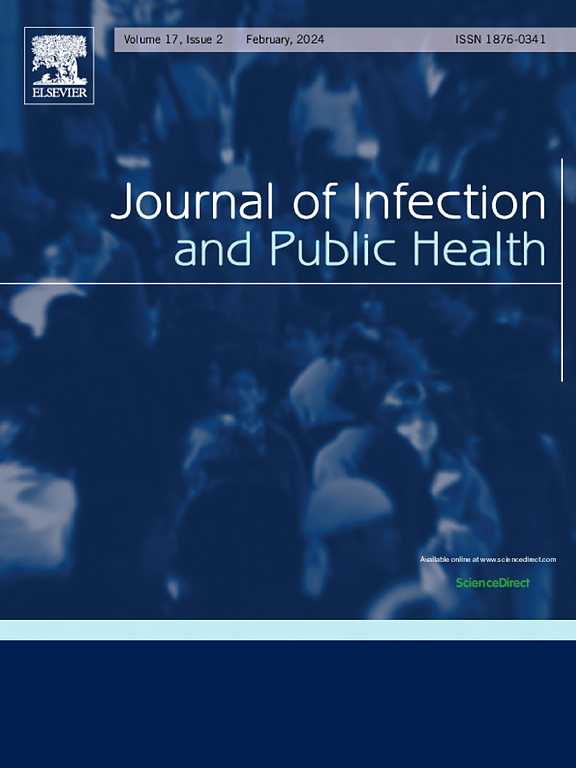对SARS-CoV-2再感染的实际评估:对疫苗的影响
IF 4.7
3区 医学
Q1 INFECTIOUS DISEASES
引用次数: 0
摘要
全球已有超过6.7亿例SARS-CoV-2确诊病例,导致687多万人死亡。再感染发生率约为0.1% ~ 6.8%。本回顾性队列研究旨在比较SARS-CoV-2再感染和初次感染的短期循环和呼吸道后遗症的风险,并评估疫苗接种的影响。方法使用TriNetX美国合作网络(2020-2022)的数据,根据再感染状况创建两个队列。评估的主要结局是医疗利用、循环和呼吸症状以及循环和呼吸疾病。Kaplan-Meier方法用于比较两个队列之间的风险。还进行了4个亚组分析(疫苗接种状况、年龄、性别、种族)和6个敏感性分析(严格定义、修改的排除标准、治疗、不同的COVID-19变异时间线、解决生存偏差和e值计算)。结果再感染组住院患者的医疗利用率显著降低[危险比,HR: 0.867, 95%可信区间,CI:0.839 ~ 0.896),重症监护服务0.488(0.418 ~ 0.570),机械通气0.476(0.360 ~ 0.629)],循环系统疾病风险降低[HR:缺血性心脏病、炎症性心脏病、心律失常、静脉血栓栓塞、其他心脏疾病和脑血管疾病分别为0.701 (95% CI: 0.637-0.772)、0.695(0.583-0.829)、0.660(0.605-0.719)、0.741(0.644-0.854)、0.614(0.535-0.705)和0.758(0.656-0.876),肺炎、其他急性下呼吸道感染、哮喘和低氧血症等呼吸系统疾病的风险较低[HR: 0.302 (95% CI: 0.302):分别为0.273 ~ 0.333)、0.811(0.686 ~ 0.958)、0.791(0.735 ~ 0.850)、0.392(0.338 ~ 0.455)。接种疫苗的再感染队列在医疗利用、循环系统疾病或呼吸系统疾病方面没有显着差异,但呼吸异常的风险更高。呼吸异常[HR: 1.195 (95% CI: 1.087-1.313)]。结论再感染个体在循环和呼吸系统表现出较轻的短期后遗症。接种疫苗可预防心血管或呼吸系统疾病。本文章由计算机程序翻译,如有差异,请以英文原文为准。
Real-world assessment of reinfection with SARS-CoV-2: Implications for vaccines
Background
There have been over 670 million confirmed cases of SARS-CoV-2 infection globally, resulting in over 6.87 million deaths. With approximately 0.1 %−6.8 % experiencing reinfection. This retrospective cohort study aimed to compare the risk of short-term circulatory and respiratory sequelae between SARS-CoV-2 reinfection and initial infection, and assess the impact of vaccination.
Method
Data from the TriNetX US Collaborative network (2020–2022) were used to create two cohorts based on reinfection status. The main outcome assessed were medical utilization, circulatory and respiratory symptoms, and circulatory and respiratory diseases. The Kaplan-Meier method was used to compare the risks between two cohorts. Four subgroup analyses (vaccination status, age, sex, race) and six sensitivity analyses (rigorous definition, modified exclusion criteria, treatment, different COVID-19 variants timeline, address survivorship bias, and E-value calculation) were also conducted.
Results
The reinfection cohort showed a significant reduction in medical utilization [ Hazard ratio, HR: 0.867, (95 % confidence interval, CI:0.839–0.896) for hospitalization, 0.488 (0.418–0.570) for critical care services, and 0.476 (0.360–0.629) for mechanical ventilation], lower risk of circulatory diseases [ HR: 0.701 (95 % CI:0.637–0.772), 0.695 (0.583–0.829), 0.660 (0.605–0.719), 0.741 (0.644–0.854), 0.614 (0.535–0.705), and 0.758 (0.656–0.876) for ischemic heart disease, inflammatory heart disease, dysrhythmias, venous thromboembolism, other cardiac disorders, and cerebrovascular diseases, respectively], and lower risk of respiratory diseases such as pneumonia, other acute lower respiratory infections, asthma, and hypoxemia [HR: 0.302 (95 % CI: 0.273–0.333), 0.811 (0.686–0.958), 0.791 (0.735–0.850), and 0.392 (0.338–0.455), respectively]. The vaccinated reinfection cohort showed no significant differences in medical utilization, circulatory diseases, or respiratory conditions but had a higher risk of breathing abnormalities. breathing abnormalities [HR: 1.195 (95 % CI:1.087–1.313)].
Conclusions
The individuals who experienced reinfection exhibited milder short-term sequelae in the circulatory and respiratory systems. Vaccine administration protects against cardiovascular or respiratory systems.
求助全文
通过发布文献求助,成功后即可免费获取论文全文。
去求助
来源期刊

Journal of Infection and Public Health
PUBLIC, ENVIRONMENTAL & OCCUPATIONAL HEALTH -INFECTIOUS DISEASES
CiteScore
13.10
自引率
1.50%
发文量
203
审稿时长
96 days
期刊介绍:
The Journal of Infection and Public Health, first official journal of the Saudi Arabian Ministry of National Guard Health Affairs, King Saud Bin Abdulaziz University for Health Sciences and the Saudi Association for Public Health, aims to be the foremost scientific, peer-reviewed journal encompassing infection prevention and control, microbiology, infectious diseases, public health and the application of healthcare epidemiology to the evaluation of health outcomes. The point of view of the journal is that infection and public health are closely intertwined and that advances in one area will have positive consequences on the other.
The journal will be useful to all health professionals who are partners in the management of patients with communicable diseases, keeping them up to date. The journal is proud to have an international and diverse editorial board that will assist and facilitate the publication of articles that reflect a global view on infection control and public health, as well as emphasizing our focus on supporting the needs of public health practitioners.
It is our aim to improve healthcare by reducing risk of infection and related adverse outcomes by critical review, selection, and dissemination of new and relevant information in the field of infection control, public health and infectious diseases in all healthcare settings and the community.
 求助内容:
求助内容: 应助结果提醒方式:
应助结果提醒方式:


